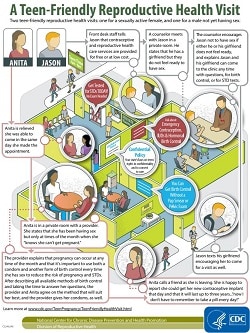Health Care Providers and Teen Pregnancy Prevention
Teen birth rates in the United States have declined to the lowest rates seen in seven decades, yet still rank highest among developed countries. Contributing to this decline are increases in the proportion of teens who have never had sex, combined with increases in contraceptive use among sexually active teens.1,2 As a health care provider, you play a critical role in further reducing teen pregnancy rates through the care you provide to your adolescent patients.
Teens need regular health care services to receive comprehensive sexual and reproductive health counseling about the importance of delaying the initiation of sexual activity and about their contraceptive options. They need counseling on which method would be best for them, and on how to use that method correctly and consistently. Parents and guardians also need guidance and information to help them talk with their teens about sex, pregnancy, and contraception.
What Health Care Providers Can Do
- Make your clinic teen-friendly . Provide your adolescent patients with confidential, private, respectful and culturally competent services, convenient office hours, and complete information. Learn more about the elements of a youth-friendly contraceptive and reproductive health services clinic.
- Learn more about the tools and resources for serving teens, as well as detailed sexually transmitted diseases (STD) guidance.
- Follow professional guidelines that recommend all teens have their first reproductive health visit between ages 11 and 15 years, with regular reproductive health visits throughout the adolescent years. Some discussions, such as sexual history taking and counseling, may best be had privately between the teen and the provider. Other times during the visit it may be important to include the teen’s parents or guardians. Learn more about adolescent reproductive health care—including talking with teen patients and their parents or guardians.
- Recognize that healthy adolescents may safely use any form of highly effective contraceptives, including long acting reversible contraceptives (LARC). Make sure teens who are having sex know about all methods of contraception. Learn more about the U.S. Medical Eligibility Criteria for Contraceptives (MEC).
- Teen Pregnancy Prevention: Application of CDC’s Evidence-Based Contraceptive Method Guidance slide set. This slide set provides an overview of the current trends in teen pregnancy as well as enhanced knowledge about CDC’s Evidence-Based Contraceptive Method Guidance and how the guidance can be applied in practice.
During the Clinic Visit
- Ask your adolescent patients about their past and current sexual and reproductive history.
- Counsel teens who are not sexually active to continue to wait.
- Counsel those who are sexually active that they can have less sex, or can decide not to have sex at all.
- Counsel sexually active teens on the importance of always using dual methods—such as an IUD or hormonal method, and a condom—to prevent pregnancy, and STDs including human immunodeficiency virus (HIV).
- Take the time to help sexually active teen patients make an informed decision about what contraceptive method would suit them best. Counsel them on the importance of and how to use their contraception correctly and consistently.
Counseling, screening, and treating of STDs such as chlamydia, gonorrhea, and human papilloma virus are a critical part of adolescent reproductive health visits. Read more to get updated STD screening and treatment guidelines.
- American Academy of Pediatrics Bright Futures: Guidelines for Health Supervision of Infants, Children, and Adolescents
- Get Yourself Tested (GYT) Campaign’s Clinic Tools and Resources
With a focus on STDs, the GYT Web site offers resources to help providers better serve your teen and young adult patients. Here you will find resources for talking with patients about sexual history, training resources, materials for your clinic, and information on billing for confidential services. You also will find teen-friendly office tips, and information on dealing with consent and confidentiality issues that are so important to adolescent patients.
1. Centers for Disease Control and Prevention. Sexual experience and contraceptive use among female teens—United States, 1995, 2002, and 2006–2010. Source: MMWR. 2012;61:297-301.
2. Santelli JS, Lindberg LD, Finer LB, Singh S. Explaining recent declines in adolescent pregnancy in the United States: the contribution of abstinence and improved contraceptive use. Am J Public Health. 2007;97:150-156.
